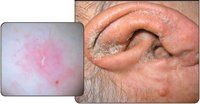- Acne
- Actinic Keratosis
- Aesthetics
- Alopecia
- Atopic Dermatitis
- Buy-and-Bill
- COVID-19
- Case-Based Roundtable
- Chronic Hand Eczema
- Chronic Spontaneous Urticaria
- Drug Watch
- Eczema
- General Dermatology
- Hidradenitis Suppurativa
- Melasma
- NP and PA
- Pediatric Dermatology
- Pigmentary Disorders
- Practice Management
- Precision Medicine and Biologics
- Prurigo Nodularis
- Psoriasis
- Psoriatic Arthritis
- Rare Disease
- Rosacea
- Skin Cancer
- Vitiligo
- Wound Care
Article
Clearing up scabies
Scabies can be safely and effectively treated with use of an appropriate scabicidal agent and a program that addresses all mite-ridden anatomic sites and sources of reinfestation. Jacob Levitt, M.D., discusses scabies diagnosis and the pharmacological and non-pharmacological components of successful treatment.

"Cases of nephritogenic streptococcus have been reported in untreated, impetiginized scabies lesions, so that prompt and aggressive therapy of this infestation is important, and superinfection must also be aggressively treated," Dr. Levitt says.
He discusses the use of dermoscopy for simplifying scabies diagnosis, dispels some existing myths about scabies and its treatment, and provides pearls for optimizing therapy.
Dermoscopy is a recent advance in scabies diagnosis, Dr. Levitt says. A study published in the Journal of the American Academy of Dermatology in 2007 (Dupuy et al) reports that when performed by an experienced dermoscopist, this technique has a sensitivity and specificity of about 90 percent. The key in dermoscopic diagnosis is to look for the "circumflex" sign at the end of the burrow.
"The diagnostic performance of dermoscopy rivals that of conventional diagnosis by microscopic examination of a skin scraping," Dr. Levitt says.
Therapeutic options

"Although there is a myth that scabies does not affect the scalp, there is no physiologic basis to support that concept, and from a practical perspective, scalp infestation is very likely to occur considering that patients may be scratching the head with their mite-ridden nails," Dr. Levitt says.
To treat the scalp, malathion lotion may be considered as an adjunct to permethrin cream. Dr. Levitt observes that using malathion for scabies represents an off-label use of malathion in the United States, where the available 0.5 percent formulation (Ovide, TaroPharma) is only labeled for head lice.
"In the U.K., malathion is sold over the counter as a 1 percent lotion for total-body application to treat scabies. There are no reported deaths or serious adverse events from such treatment, and insofar as malathion is used on the scalp routinely for head lice, no safety issues are expected to arise from a similar application in scabies," he says.
Scabies resistance is a problem with crotamiton and has also been reported for lindane. Significant clinical failure rates have been associated with both of those agents. Furthermore, while lindane is indicated for scabies treatment, it is paradoxically contraindicated for use in crusted scabies because of the increased risk of percutaneous absorption through the compromised skin barrier present in that condition. In addition, a single treatment with lindane results in the pollution of about 6 million gallons of water at a cost of about $4,000 for wastewater cleanup per lindane bottle.
Newsletter
Like what you’re reading? Subscribe to Dermatology Times for weekly updates on therapies, innovations, and real-world practice tips.











